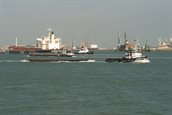The Dutch Maritime Strategy 2015 - 2025
The Dutch Maritime Strategy (not to be confused with the MSFD) is a government-level policy agenda that was drafted in collaboration with all departments that are involved in the North Sea policy.
The Maritime Strategy assumes that all sectors and companies that have a direct or indirect connection with sea and inland waterways together form an organic whole. They are the inland waterway sector, ports, maritime services (including maritime education and research institutes), offshore, shipbuilding, fisheries, hydraulic engineering, the watersport industry and shipping, each with its own suppliers and accompanying service providers.
Around 2015, the year that the Maritime Strategy was published, the Dutch maritime cluster numbered over twelve thousand companies with a total workforce of around 225,000. The value that this represented to the Dutch economy as a whole was more than EUR 20bn, or considerably more than 3 per cent of the GNP of the Netherlands. Together with the contribution of heavy industry and logistics at the ports, the contribution comes to more than 7 per cent of GNP.

Greater than the sum of its parts
The Maritime Strategy aims to combine forces and coordinate interests on different levels. Individual companies must be able to find each other, share and strengthen what they have in common, and use the combined effort to work towards the envisaged developments and innovation. In that way the diverse maritime cluster becomes a single entity as far as the government is concerned, which is a step on the way to navigating a course to the future with public/private projects.
The Maritime Strategy specifies a large number of policy intentions; they are brought together under seven topics:
• Human capital
• Innovation
• Trade
• Accessibility
• Security and the environment
• Communication
• Threats to security and stability
The Maritime Strategy indicates which party takes the lead for each topic and each measure in terms of implementation, which parties are otherwise involved and what the lead time is for the measure in question.